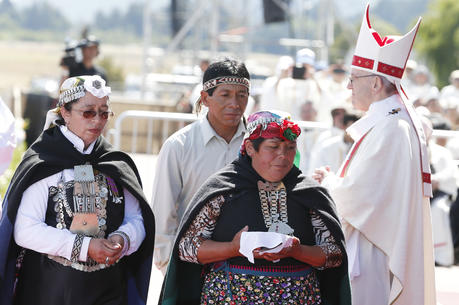In Peru, met the indigenous people and addressed the issue of corruption is addressed (Jan 18 - 21, 2018)
Pope Francis set out on his 22nd foreign trip on Jan 15, a visit to Chile and Peru that offered a number of daunting issues for him to address — from the plight of indigenous peoples, the condition of migrants, the urgent need to address poverty, inequality and corruption and the state of the environment to the question of the sexual abuse of minors by priests in Chile and lay leaders in Peru.
Jan 20, 2018

Pope Francis set out on his 22nd foreign trip on Jan 15, a visit to Chile and Peru that offered a number of daunting issues for him to address — from the plight of indigenous peoples, the condition of migrants, the urgent need to address poverty, inequality and corruption and the state of the environment to the question of the sexual abuse of minors by priests in Chile and lay leaders in Peru.
It was Francis’ sixth journey to Latin America since becoming pope. He visited Brazil for World Youth Day (2013), Ecuador, Bolivia and Paraguay (2015), Cuba (2015), Mexico (2016) and Colombia (2017). He has yet to visit his native Argentina but flew over it on route to Chile, and since it is the common practice that the Pope sends a message to the head of the state that he is passing over, there was much interest in what he said.
Fifth Day, Jan 19 - Puerto Maldonado
He flew to Puerto Maldonado, a city in south-eastern Peru, in the Madre de Dios Region, in the Amazon rainforest that is sometimes referred to as one of the two lungs of planet earth. Thirty-four million people live in the Pan-Amazon region that includes eight other countries, including more than 350 indigenous groups, but already 17 per cent of the Amazon jungle has been destroyed, putting the health of the planet at risk.
Pope Francis has spoken about this in his encyclical Laudato Si’ and in October 2017 he announced that a Special Assembly of the Synod of Bishops for the Pan- Amazonian region will be held in Rome in October 2019. His visit is being considered as the opening act of that synod and his speech is expected to be one of great importance. Here, too, he met and addressed the indigenous peoples of the Amazon and had lunch with a small group of them.
Later that day, he returned to Lima and addressed the political and civil authorities and the diplomatic corps in the government palace. His visit to Peru was originally considered the easier part of the week-long trip, but now the political climate in Peru is in turmoil.
President Pedro Pablo Kuczynskinarrowly managed to avoid impeachment for corruption thanks to support from the son of the former president Alberto Fujimori, then in prison because of corruption and human rights violations. He then granted pardon to his predecessor Fujimori, sparking outrage among many people who suffered under his regime, some of whom wanted to meet the Pope.
Pope Francis addressed the problem of corruption when he went to the coastal city of Trujillo in northwest Peru, which is considered the “cradle of liberty and cradle of the judiciary in Peru.” There he expressed his closeness to the city’s inhabitants who suffered during the severe flooding caused by El Nino in March 2017. Before returning to Lima that afternoon, he gave a talk to priests, women and men religious and seminarians.
Sixth Day, Jan 21 - Lima
Pope Francis spent Jan 21 in Lima, the capital city with 10 million inhabitants, which was founded by the Spanish conquistador, Francisco Pizzaro, on Jan 18, 1535. Known as “the city of the saints” because all five of “the great saints of the first evangelisation” lived in Lima and were renowned for their dedication to the poor and their deep spirituality.
These include St Rosa of Lima (1586-67), the first saint of Latin America, St Martin de Porres (1579-1639), renowned for his humility and patron of people of mixed race, St Toribio de Mogrovejo (1538-1606), archbishop of Lima whom Francis counts as the model for bishops in Latin America, St Francis Solano (1549- 1610), a Franciscan itinerant preacher and confessor and St Juan Massias (1585-1646), friend of St Martin de Porres and a Dominican lay brother.
Francis referred to these saints on his last day in Peru, as he sought to confirm the faith of the people during his visit to the Sanctuary of the Lord of the Miracles (El Santuario del Señor de Los Milagros). He addressed the bishops at the open-air Mass he celebrated before taking the plane back to Rome. --By Gerard O’Connell, America Magazine







Total Comments:0